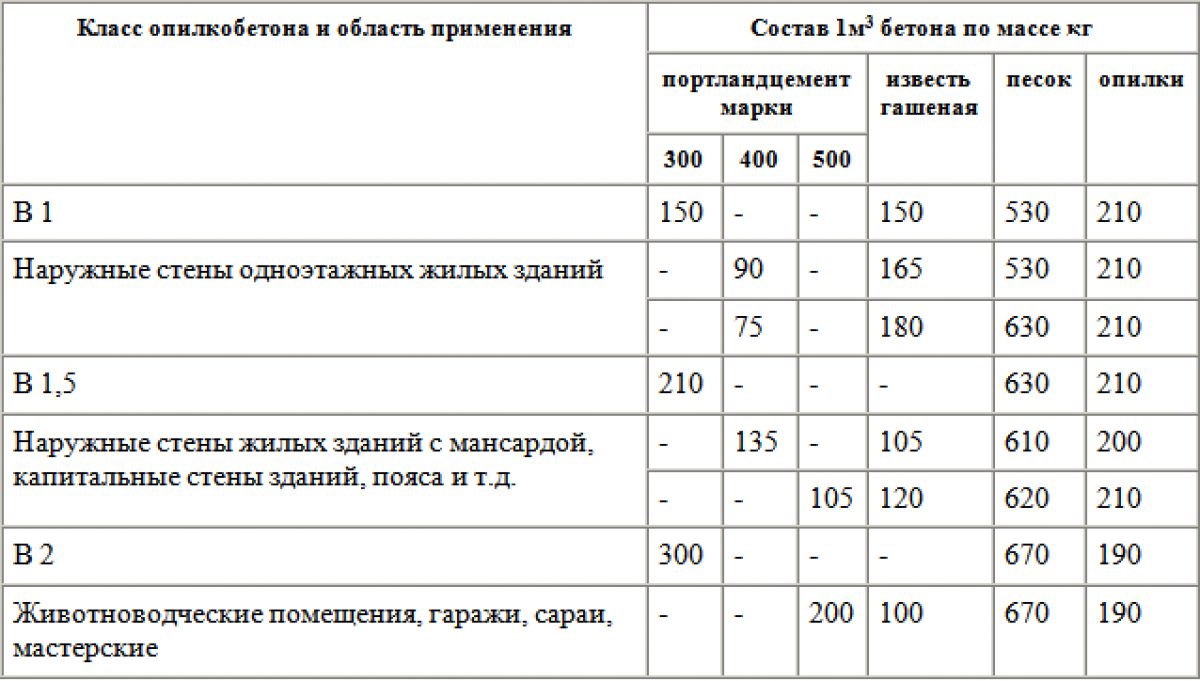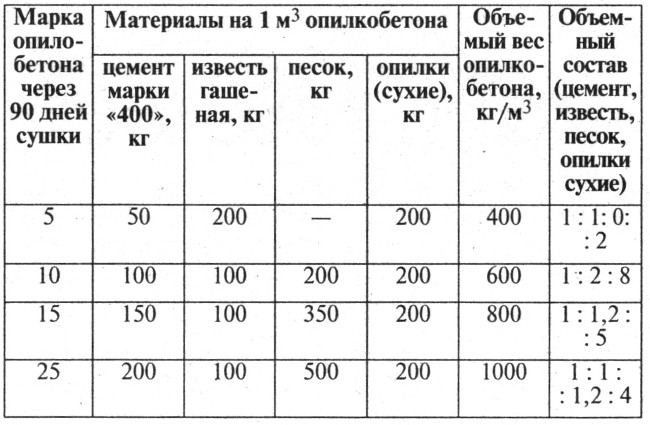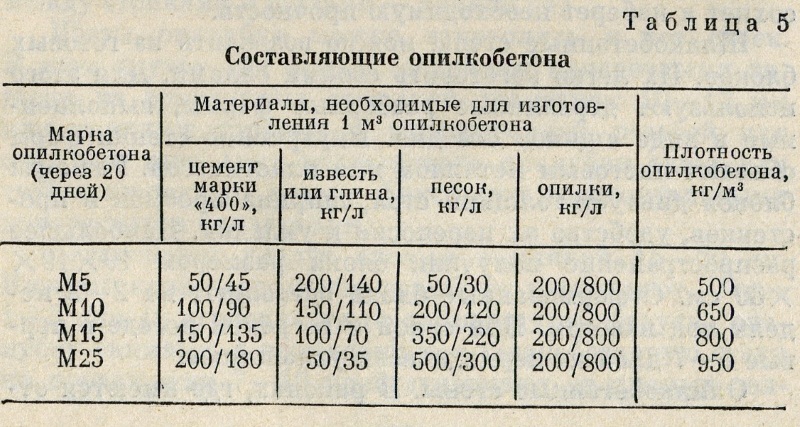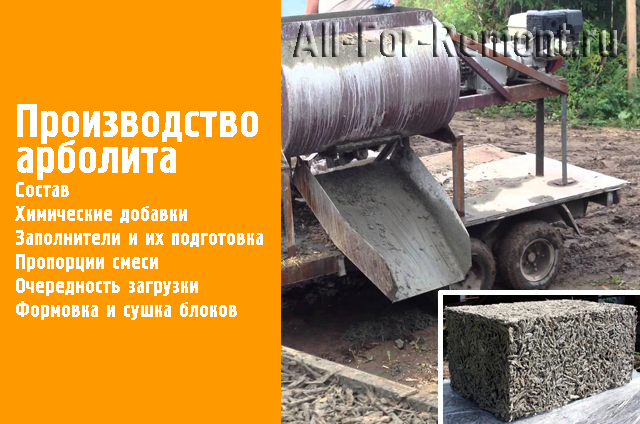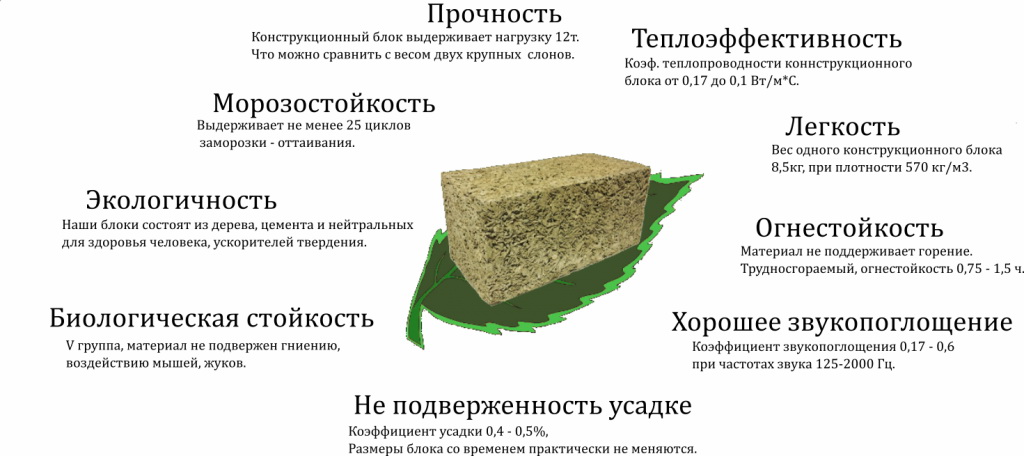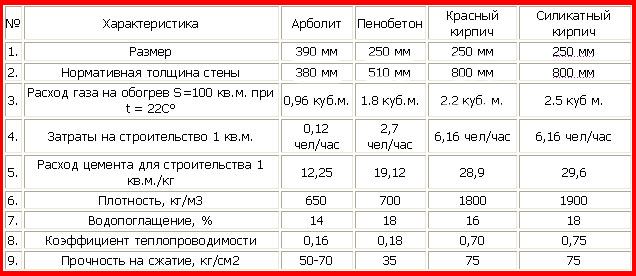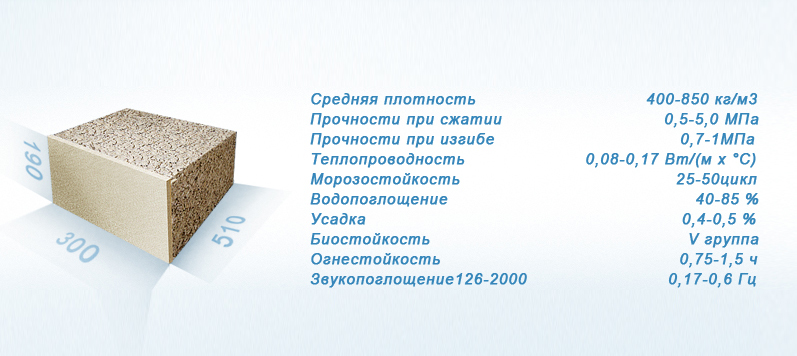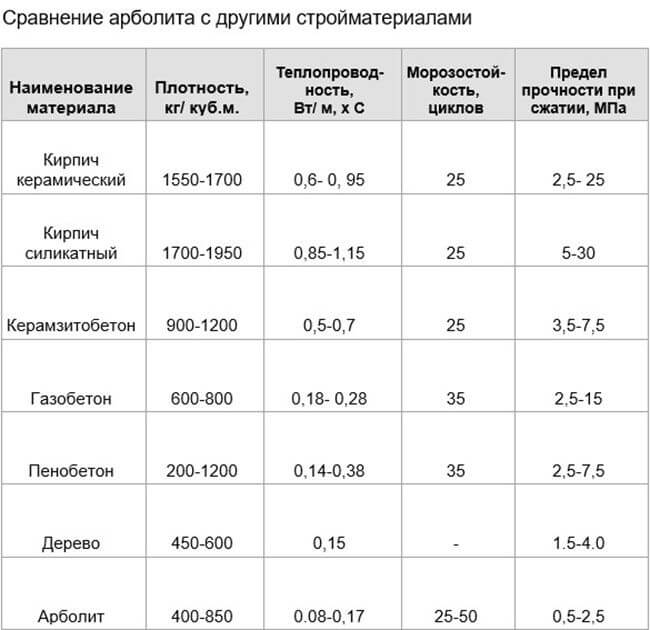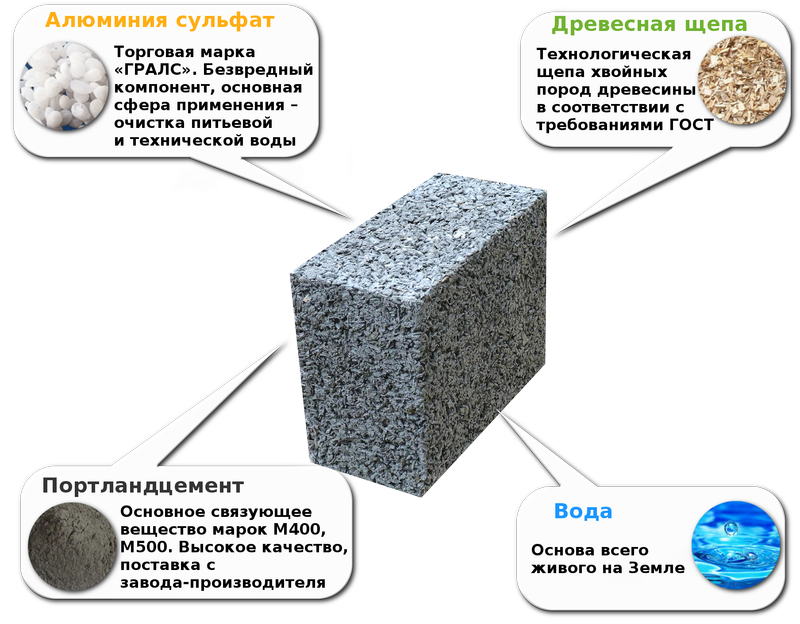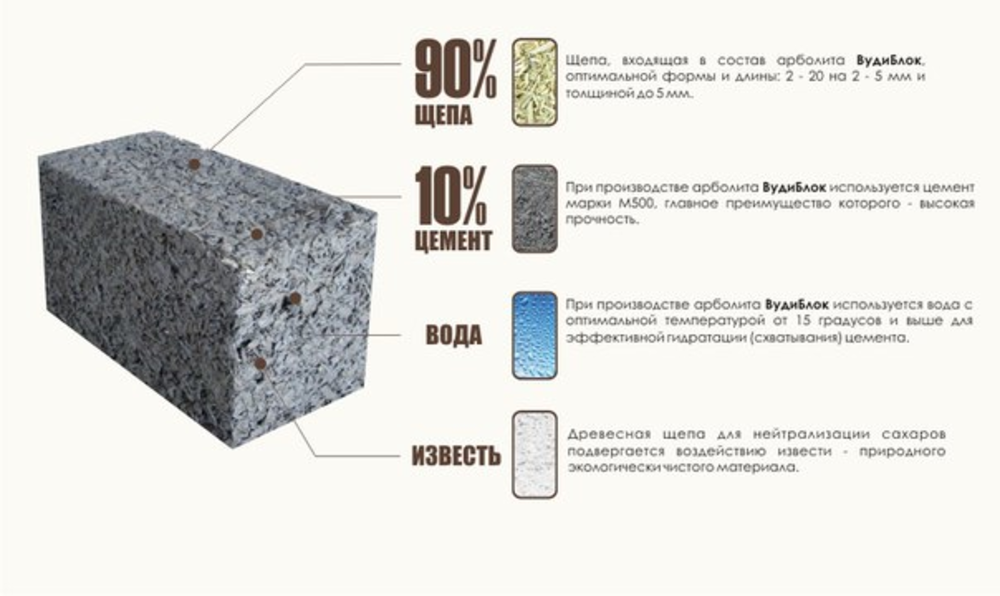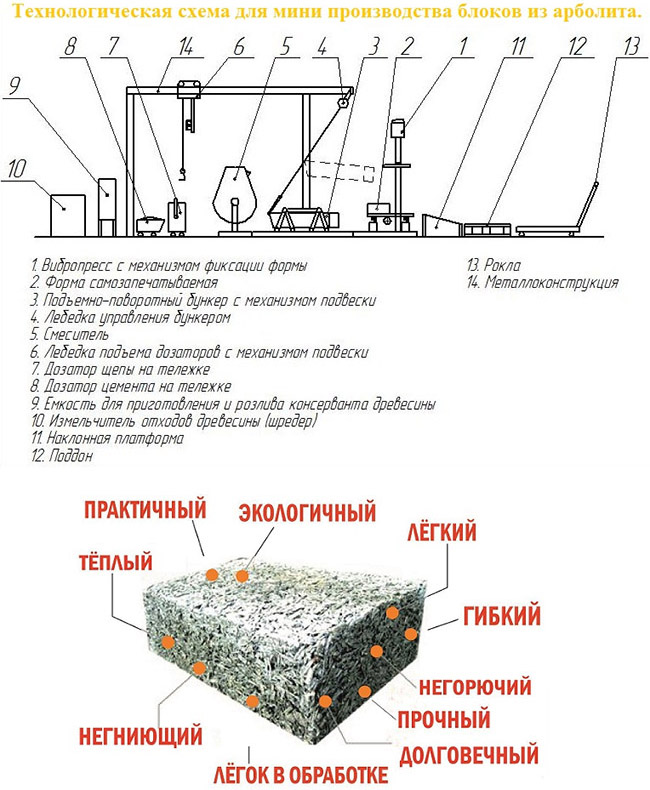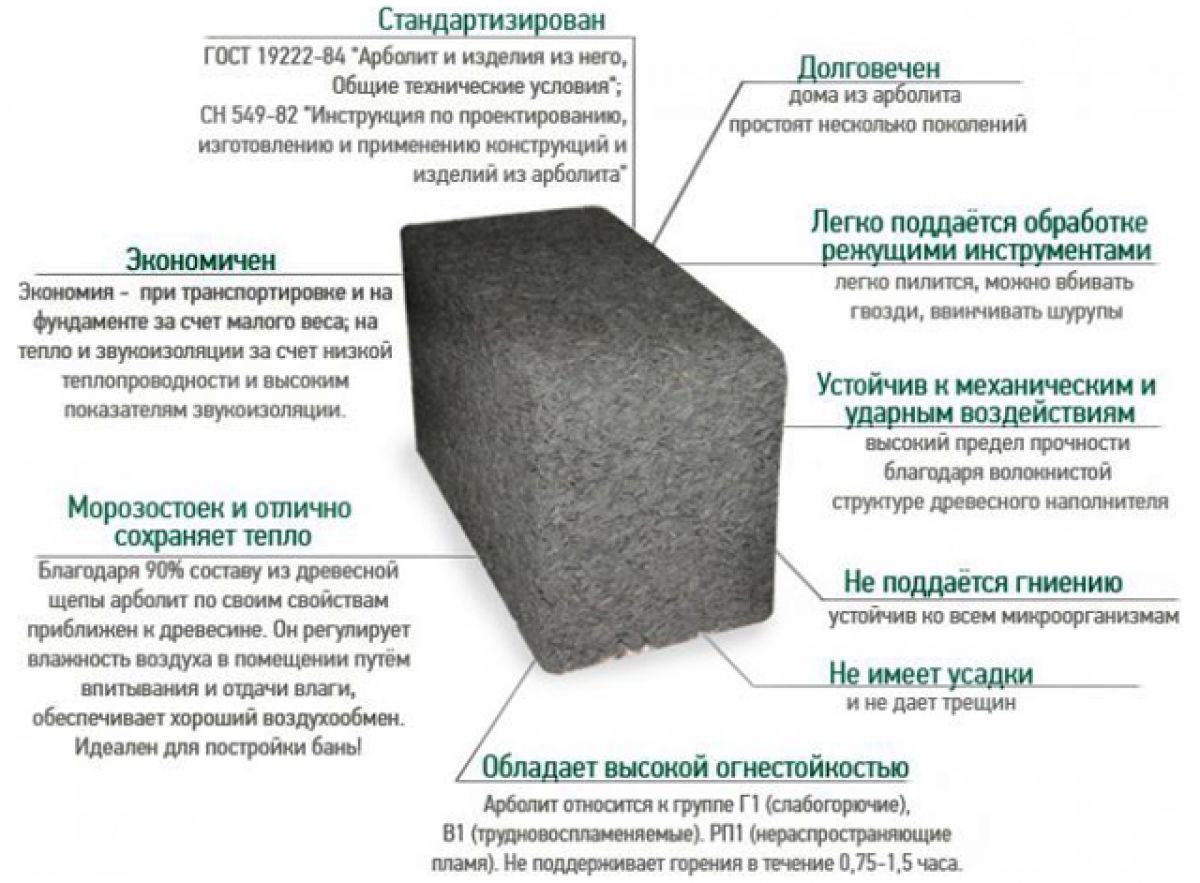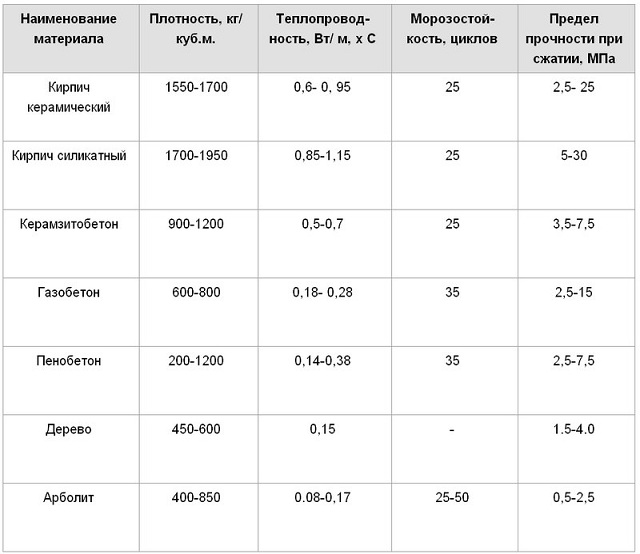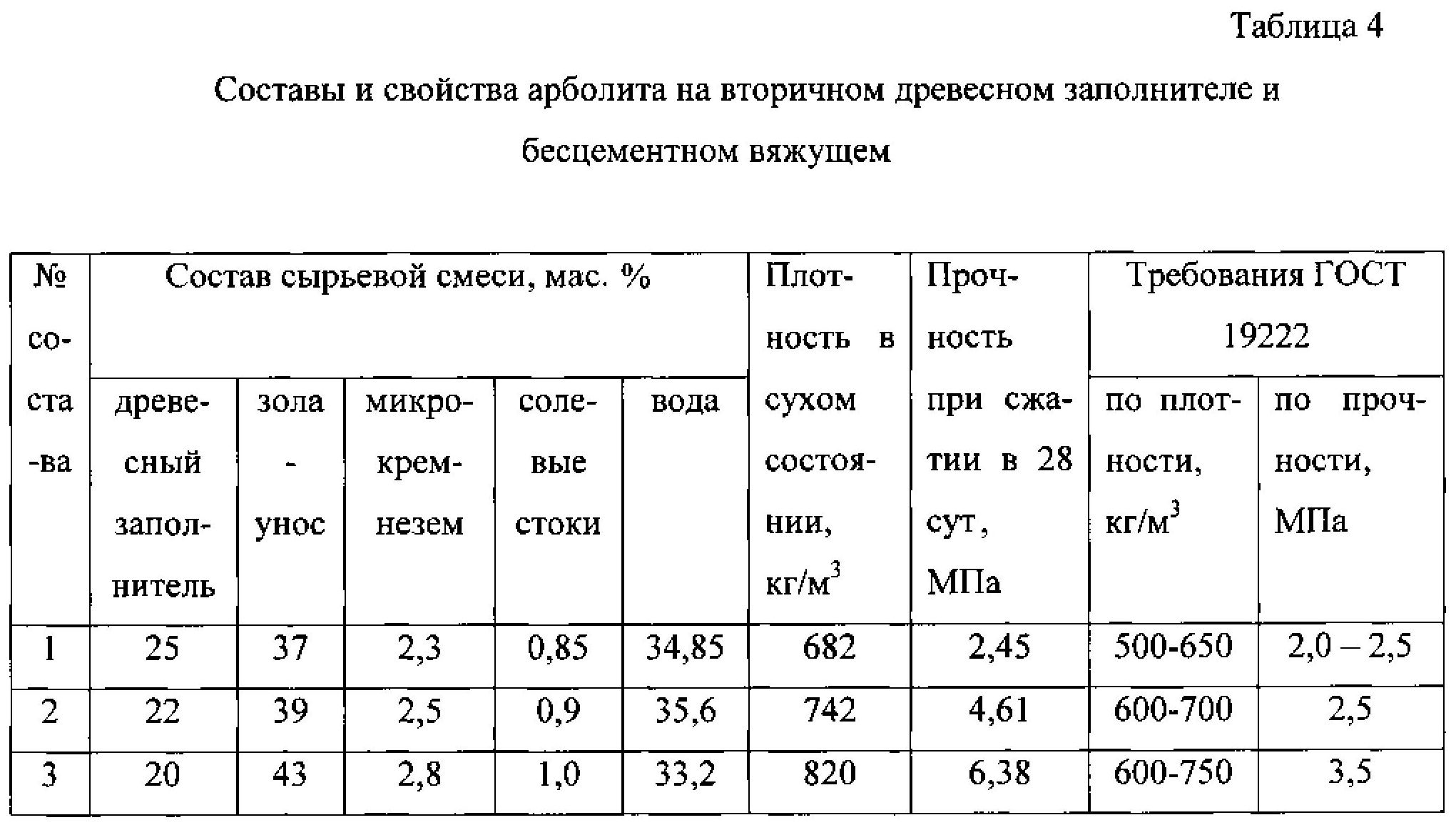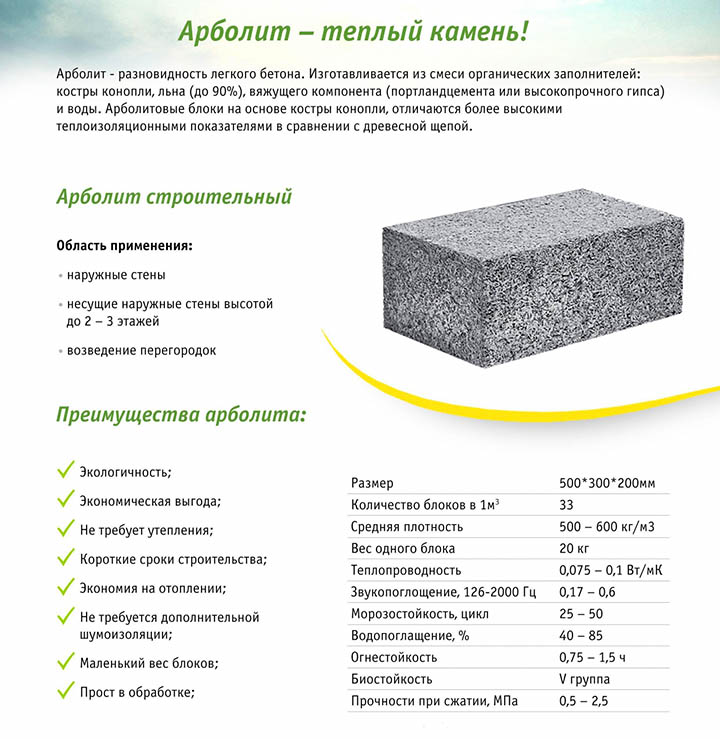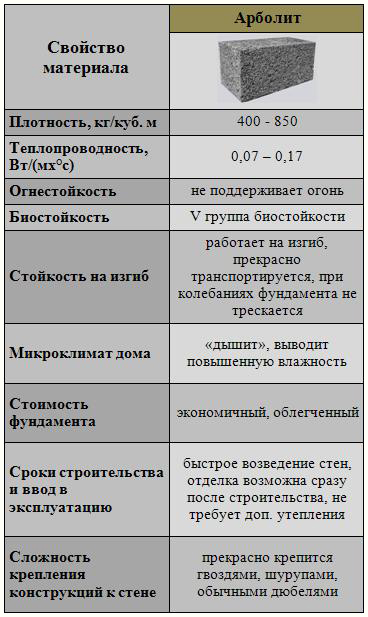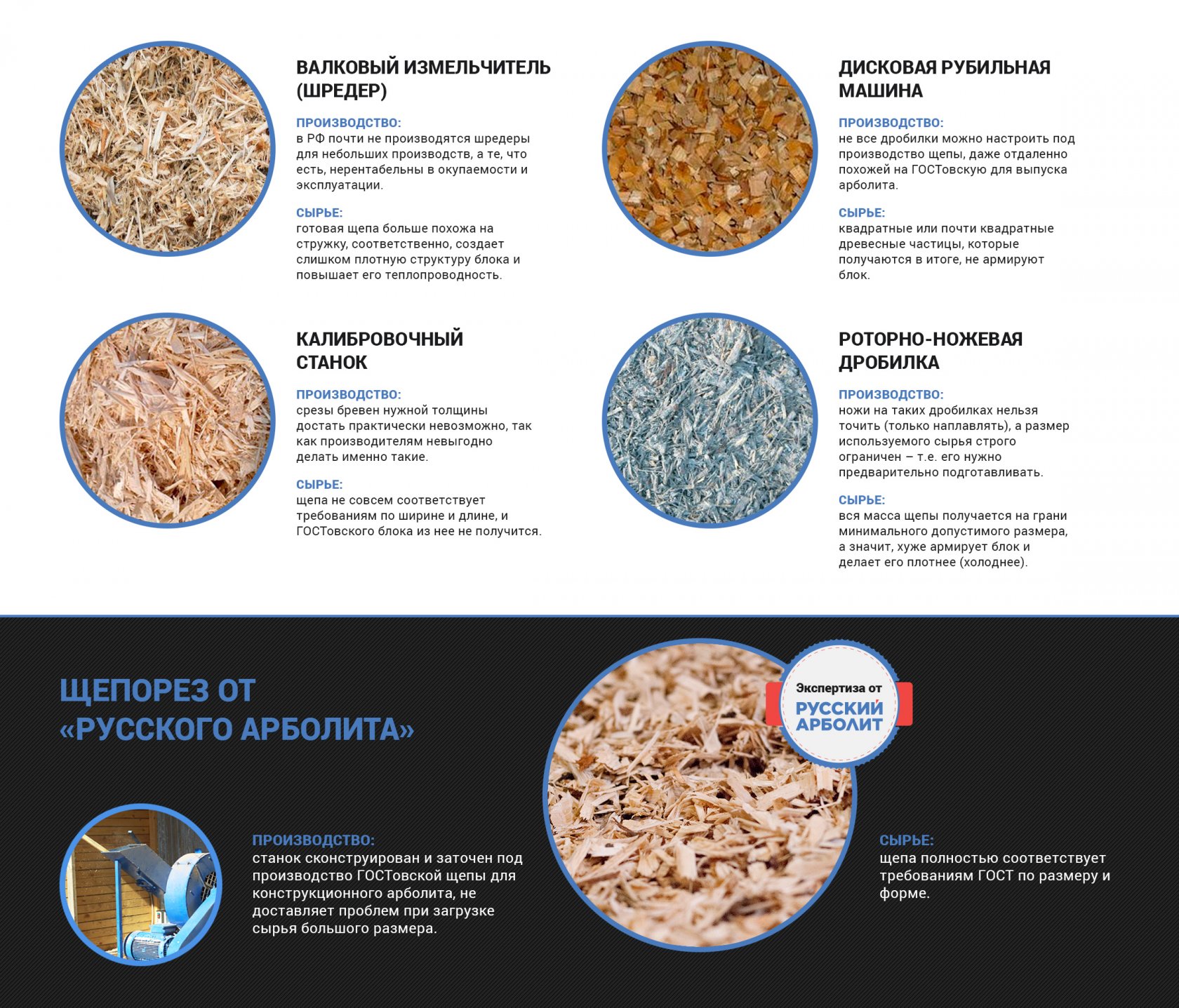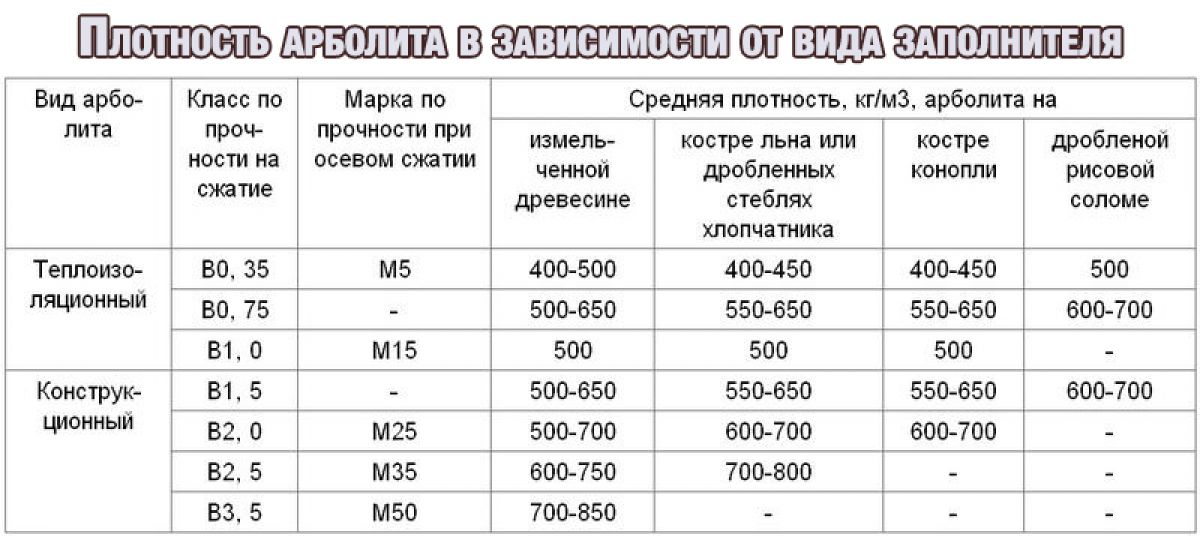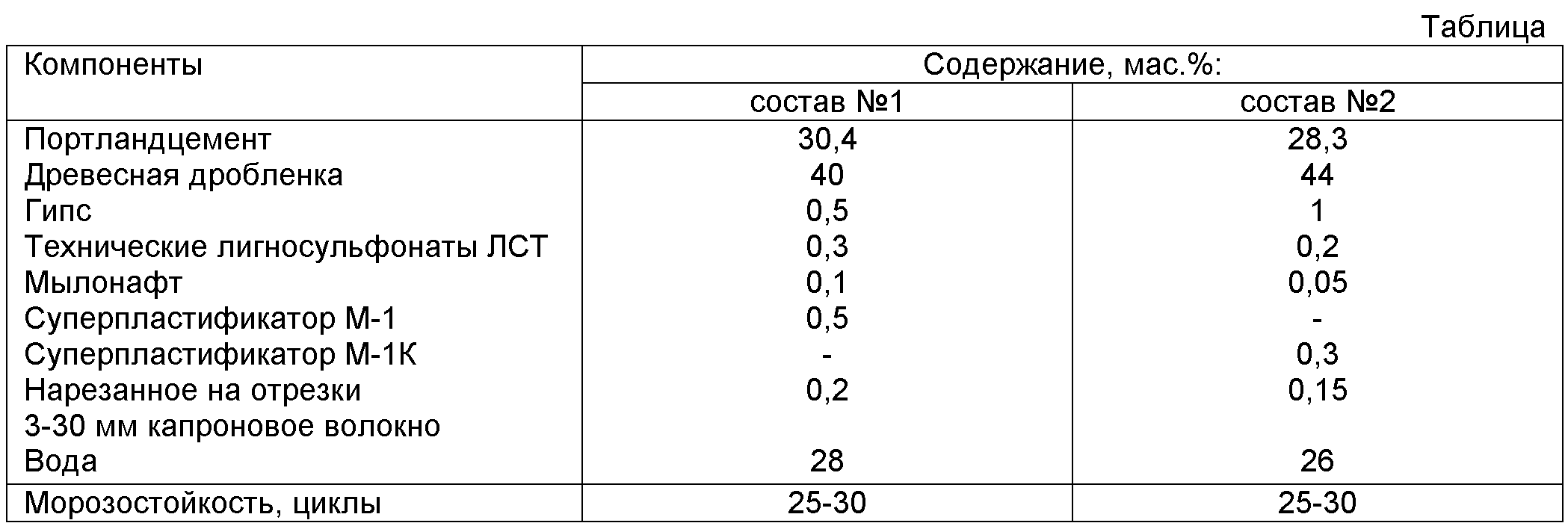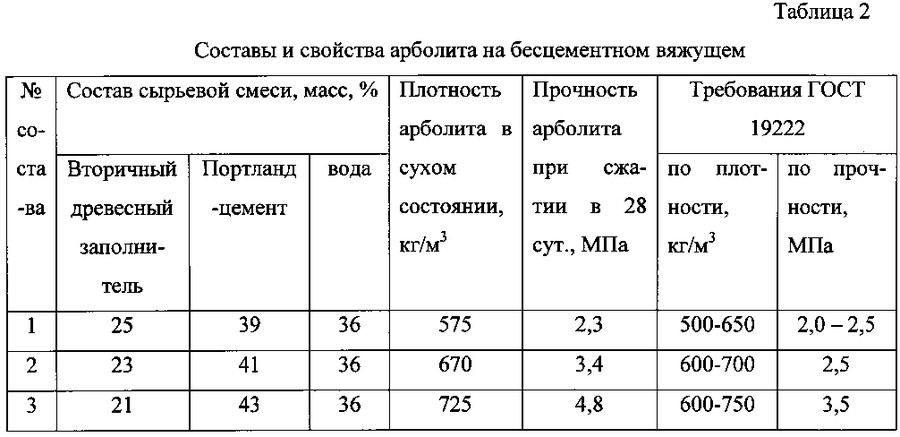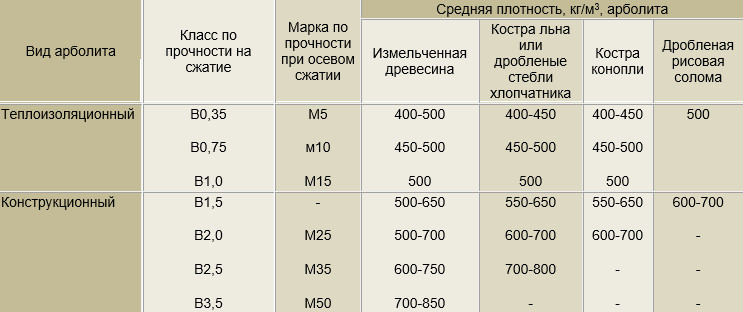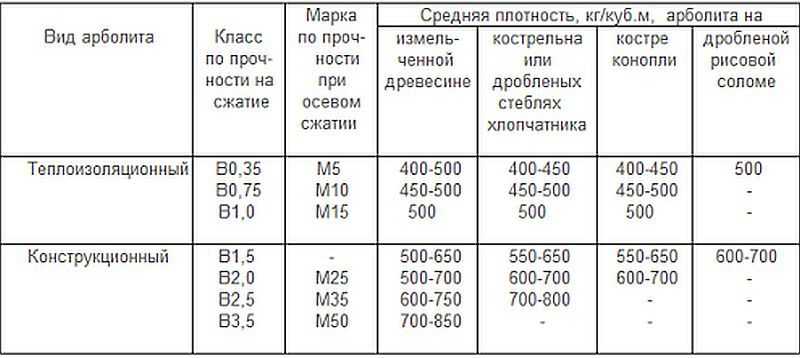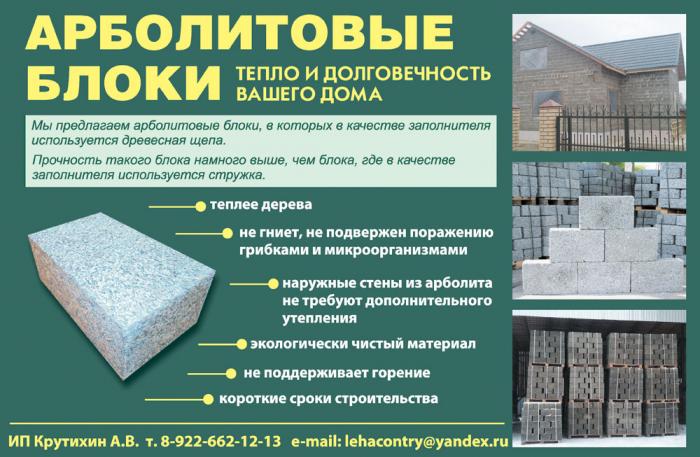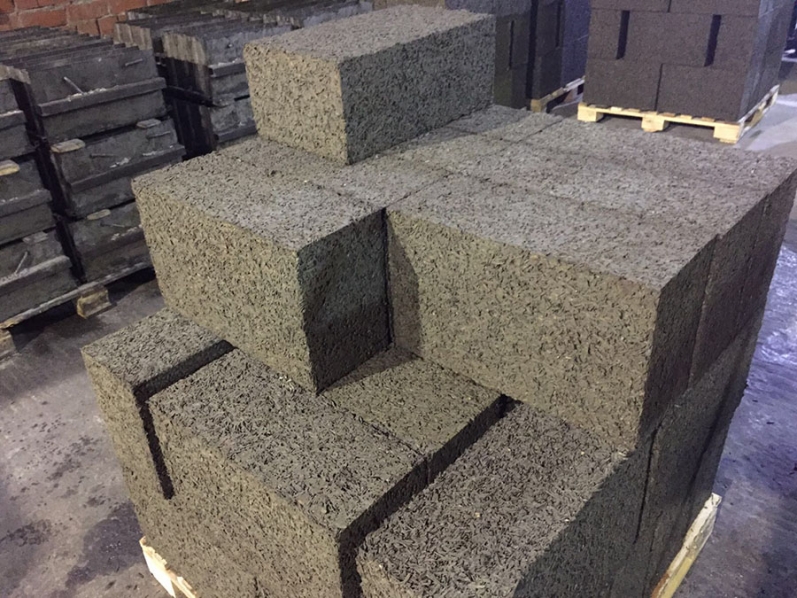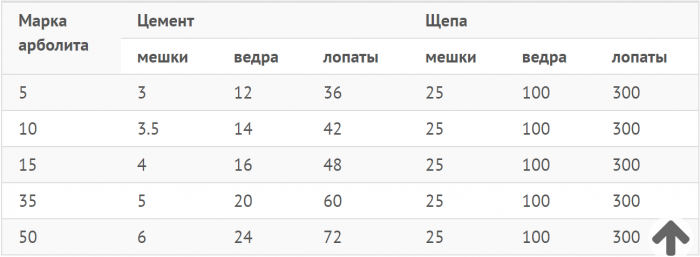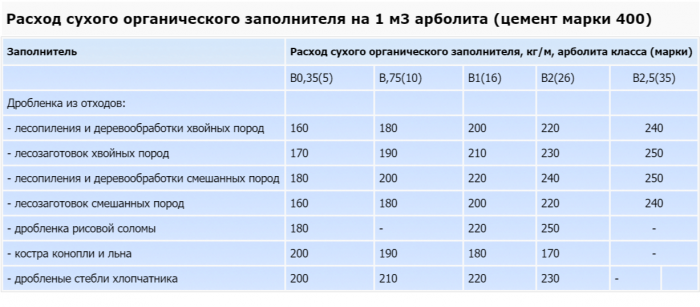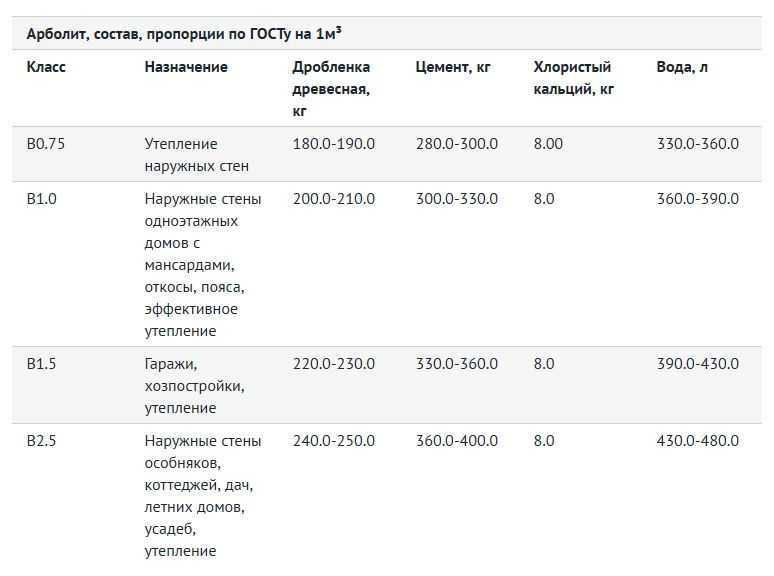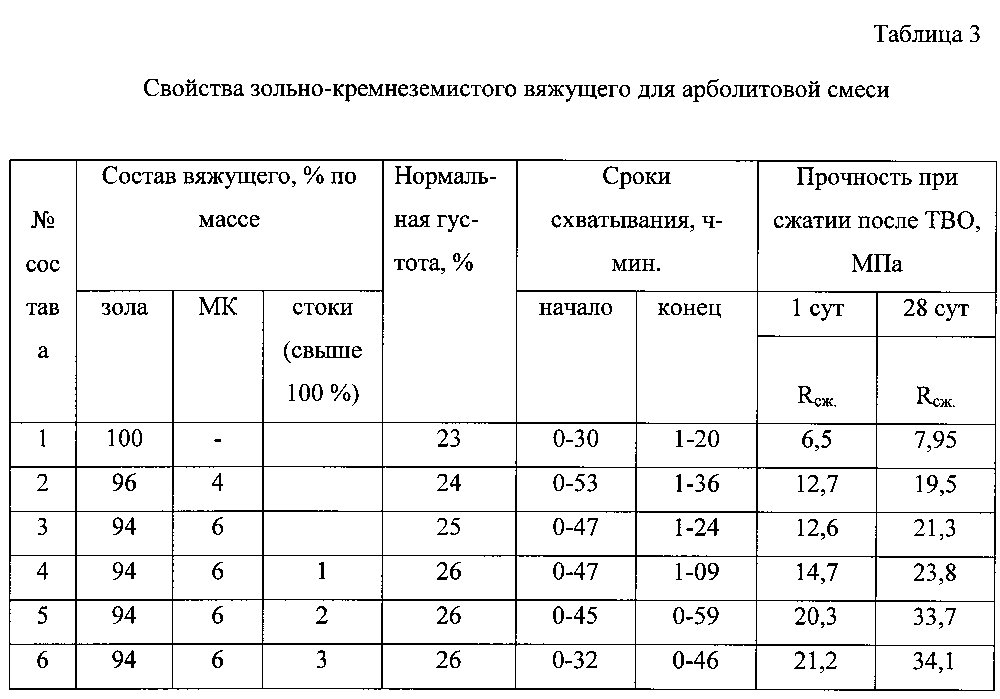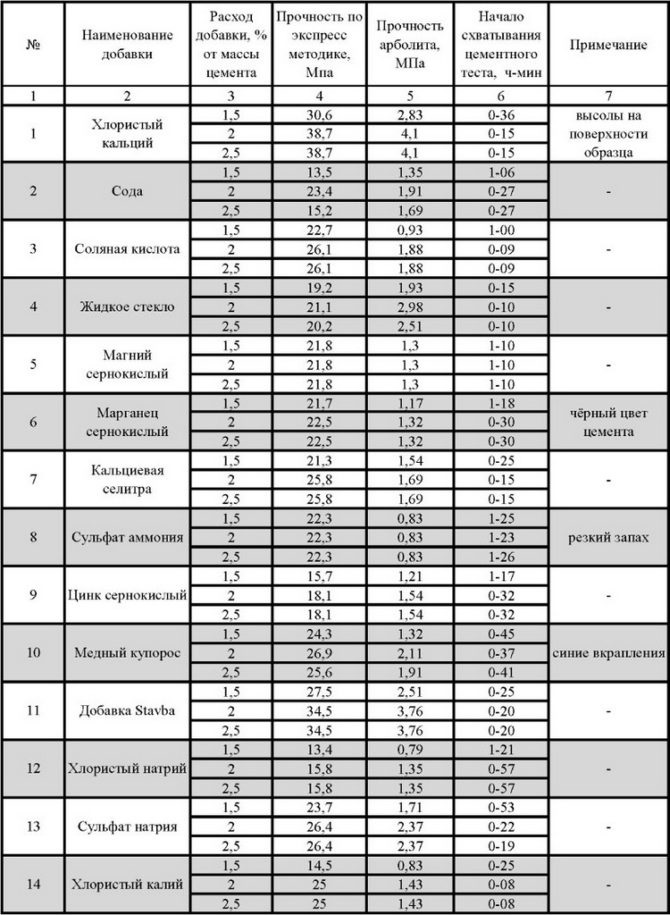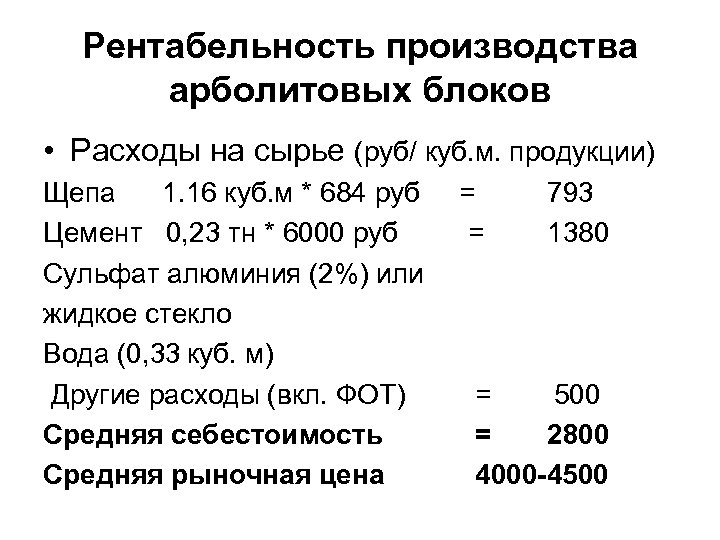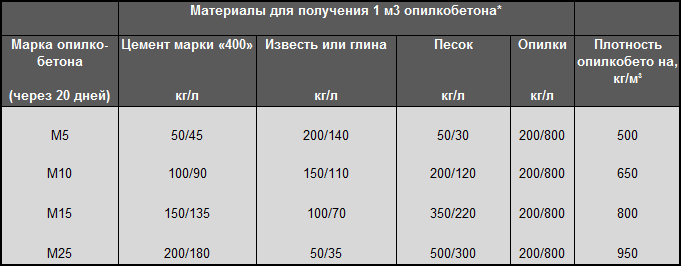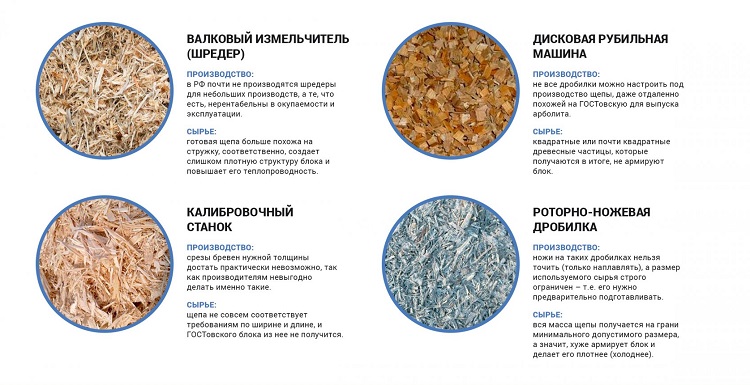Composition according to GOST
The composition of wood concrete blocks is established by GOST 19222-84 "Wood concrete and products from it". The composition of arboconcrete contains:
- binder - cement, concrete or cement composition on lightweight aggregates (expanded clay, perlite, vermiculite);
- filler - wood chips, stalks of cotton, flax or hemp fire, rice straw, up to 5% of tree bark and needles;
- chemical additives.
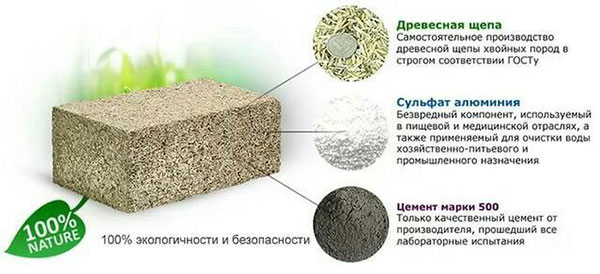
Let's talk about the components in more detail.
Organic ingredients
Fillers of organic origin provide the lightness and heat-insulating qualities of the wood block, they occupy 80-90% of the volume of the mixture for the formation of wood concrete.
Important!
Any fillers should not be affected by mold or rot, in winter they should not contain ice and snow.
Wood chips
Wood chips of deciduous or coniferous (except for larch) tree species, strictly calibrated in size, are used. GOST allows the limiting size of chips to be 40x10x5 mm, but it has been experimentally found that the best blocks are obtained using needle-type chips with a size of 25x10x5 mm.
Attention! With a larger size of this component, the strength characteristics of the material deteriorate, with a smaller size, the thermal insulation qualities are reduced.
In industrial plants for the production of wood concrete, special crushers are installed to obtain chips of the desired size; in handicraft production, chips are often replaced with larger chips, but the result is unpredictable, such blocks often cannot pass certification.
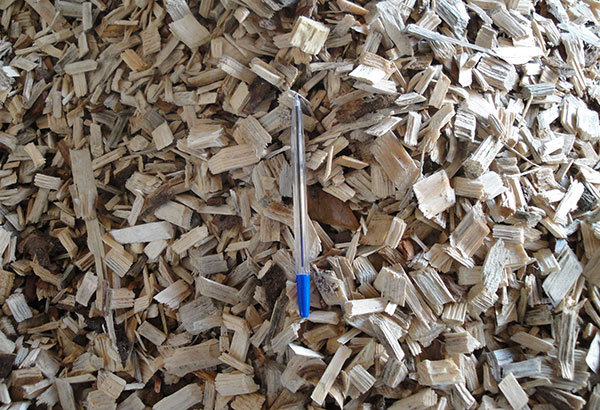
Rice straw, cotton, flax and hemp
Arbolite on rice straw, fire of flax or hemp, cotton stalks has a lower strength grade, but the best indicator of thermal conductivity, it is not recommended to build houses from such stones above one floor, but slabs with this filler are used to insulate various structures.
The length of the filler is allowed up to 40 mm, the width is 5 mm, while the fleece and tow is allowed in quantity not more 5%.
Inorganic components
To reduce water absorption and exclude the possibility of wood rotting inside the block in conditions of high humidity and temperature, the fillers are treated with chemicals in the amount of 2-4% of the volume.
Aluminum sulfate
Aluminum sulphate Al2 (SO4) 3 is added to increase the strength characteristics, since it neutralizes the natural sugars contained in the wood, thereby preventing the decay process.
Slaked lime
Lime Ca (OH) 2 is used in the form of milk, the filler is soaked in it for 1-2 days, then it is dried in air for 90 days, stirring regularly.
Water is used purified from impurities, with a temperature of + 15C, but in fact, in the production of arbolite mixture, they take water from wells, open sources or a water supply system.
Sizes of wood concrete according to GOST. Composition
Like any concrete, the material includes a cementitious substance and filler - only of organic origin, as well as various additives. The origin and properties of the ingredients affect the quality of the final product.
Organic fillers impart very significant heat and sound insulation properties to wood concrete. In terms of strength, the material is not much inferior to concrete with the same density indicators. This combination of qualities is possible only with the right choice of raw materials.
We will talk about how to make wood chips for the production of wood concrete with our own hands below.
In more detail about how to choose a composition for wood concrete and sawdust concrete, this
Organic ingredients
Several types of material are used in the form of wood filler. Not all shavings are suitable as raw materials - do not confuse the material with sawdust concrete.The new GOST clearly regulates the size and geometry of the fractions added to the wood concrete.
Not every tree is suitable for chips: you can use spruce, pine, aspen, birch, beech, but larch is undesirable. Before use, wood material must be treated with antiseptic compounds to prevent the development of mold or fungi.
- Shredded bark and needles can also be applied. However, their share is less: bark should be no more than 10% of the mass of the product, and needles - no more than 5%.
- The raw materials can be rice straw, fire flax and hemp, as well as cotton stalks. The materials are crushed: the length should not exceed 40 mm, the width - 2–5 mm. Feathers and tow, if they are in the filler, do not exceed 5% by weight. GOST 19222-84 regulates the size of fractions that are obtained by grinding one or another raw material. And although deviations are allowed in the proportion of ingredients, it is impossible to deviate from the raw material standards.
Flax contains a large amount of sugars, and the latter, reacting with cement, destroy it. Preliminarily, a fire of flax is soaked in milk of lime - 1-2 days, or kept in the air for 3-4 months.
Inorganic components
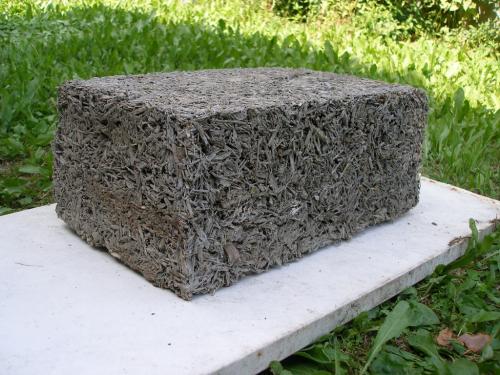 The following substances act as binder in wood concrete, which is exactly what the arbolite is called:
The following substances act as binder in wood concrete, which is exactly what the arbolite is called:
- Portland cement is a traditional material and the most popular;
- Portland cement with mineral additional components - usually, thus increasing the frost resistance of blocks;
- sulfate-resistant cement, with the exception of pozzolanic, provides resistance to chemically aggressive substances.
According to the requirements of GOST, only material of the corresponding brand can be used:
- not less than 300 for heat-insulating wood concrete;
- not less than 400 for structural.
Now let's talk about the proportions of chemical additives in the wood concrete composition.
Chemical additives
The total amount of additional ingredients can be up to 2–4% by weight of the cement. Most of them increase the strength of wood concrete: substances interact with sugars that are present in wood, and form compounds that are harmless to cement.
The specific amount of ingredients is determined by the brand of wood concrete. For example, grade 30 wood concrete may include:
- calcium chloride and aluminum sulfate in a ratio of 1: 1 - no more than 4% by weight of cement;
- calcium chloride and sodium sulfate in a ratio of 1: 1 - no more than 4%;
- aluminum chloride and aluminum sulfate in a ratio of 1: 1 - no more than 2%;
- calcium chloride and aluminum chloride in a ratio of 1: 1 - no more than 2%.
Liquid glass - sodium and potassium silicates - can also be used for the same purposes.
Water
GOST regulates the degree of purity of water, but in practice any is used - a central water supply system, wells, a well. For the quality of wood concrete, the water temperature is fundamental. It is added to the composition along with additional ingredients.
In order for the rate of cement hydration to be sufficient, water with a temperature of at least + 15 ° C is needed. Already at + 7– + 8 ° C, the cement setting rate noticeably decreases.
Materials for wood concrete
Arbolite of any brand is made from 3 main components, with the addition of some chemicals:
1. Organic fillers:
- chips;
- wood shavings;
- sawdust.
2. Aggregate (binder) - Portland cement grade 400 or 500.
3. Water.
Chemical additives are needed primarily to neutralize the sugar contained in the wood material. Partially the same problem is solved by obligatory exposure of wood chips, shavings and sawdust in the open air for 3 - 4 months. In addition, during such ventilation, the wood loses a significant part of its internal moisture.
It is advisable to use all 3 fractions of wood waste for the best filling of wood concrete. The chips should not be large: no longer than 40 mm (preferably 25 - 30) and no thicker than 5 mm (preferably 1 - 2). Such chips are obtained by cylindering tree trunks for chopped houses or by planing.
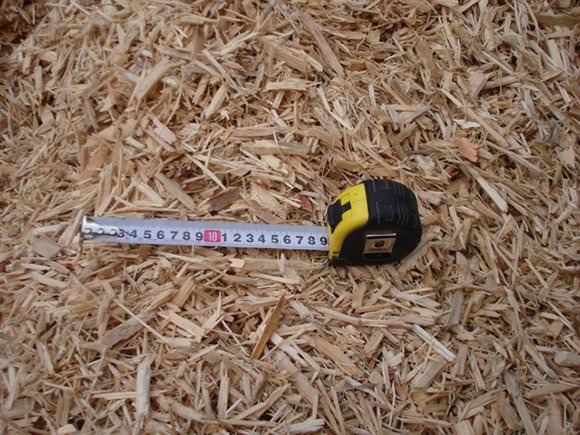
It is best to use coniferous wood waste: pine, spruce, fir, but you can also use hardwood chips. Do not use larch and beech wood waste. It is also not recommended to use chips and shavings of dry wood, only freshly sawn trees will give a needle (with sharp and fleecy edges), the most suitable material for wood concrete.
We will not talk much about cement and water, their quantity is introduced according to proportions, is corrected experimentally and depends on the quality of the first and the degree of moisture and characteristics of the filler. But the following substances are used as chemical additives for wood concrete:
- lime (slaked or quicklime - in different recipes);
- liquid glass (silicate glue);
- calcium chloride;
- sulphate aluminum.
At enterprises that industrially produce wood concrete blocks, this list can be 3 times more impressive, but we will consider only chemical additives that are usually used in the manufacture of wood concrete blocks with our own hands, those that you will not waste a lot of money and time to find. You can easily find the first 2 components in any hardware store, and the other 2 are ready to be sent to you in a small package by hundreds of Russian suppliers without any problems.
Types and sizes of blocks
Arbolite panels are divided into several types:
- large-format blocks (intended for wall capital masonry);
- hollow products of various sizes;
- plates for strengthening thermal insulation.

Also, liquid mixtures are made from wood concrete, with which the enclosing structures are poured. But most often, in practice, the word "arbolit" is understood as masonry elements with or without facing. Most often, blocks with a size of 50x30x20 cm are made. However, more and more the range is expanding, and manufacturers are mastering new positions. The technical characteristics of the produced blocks are provided only in the complete absence of impurities.
Elements with a density of 500 kg per 1 cu. m. and more are traditionally considered structural, less dense - intended for thermal insulation. They can be used where the load from above is taken up by other parts of the structure. Usually, the density is measured only after the block has lost all excess moisture.


To build load-bearing walls of single-storey houses, the height of which does not exceed 3 m, it is necessary to use blocks of at least B 1.0 category. If the structures are higher, products of category 1.5 and higher are required. But two-story and three-story buildings should be built from wood concrete of group B 2.0 or B 2.5, respectively.
In fact, usually the walls of residential buildings from blocks of 50x30x20 cm are laid out in one row, strictly flat. If it is necessary to form auxiliary thermal insulation, a so-called warm plastering system is made of wood concrete. It is prepared by adding perlite and creating a layer of 1.5 to 2 cm.
When the premises are not heated or are heated from time to time, use the method of masonry on the edge. Heat-shielding wood concrete blocks have a water absorption coefficient of no more than 85%. For structural elements, the permissible value is 10% lower.
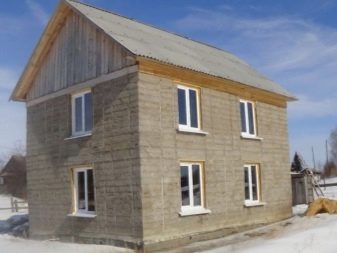

It is customary to divide wood concrete blocks into three categories according to fire protection:
- G1 (difficult to ignite);
- B1 (highly flammable);
- D1 (low-smoke elements).

The need to produce wood concrete at home is largely due to the fact that existing manufacturers often produce low-quality goods. Problems can mainly be associated with insufficient strength, weak resistance to heat transfer, or violation of geometric parameters. Blocks of any kind should certainly be covered with plaster. It reliably protects against wind blowing. Only finishing coatings capable of "breathing" are combined with wood concrete.
There are 6 brands of wood concrete blocks, distinguished by the level of frost resistance (from M5 to M50).The number after the letter M shows how many cycles of transition through zero degrees these blocks can transfer.
Most often, their size is 40x20x30 cm. Depending on the device of the groove-comb system, the area of the masonry and the thermal conductivity of the walls depend.
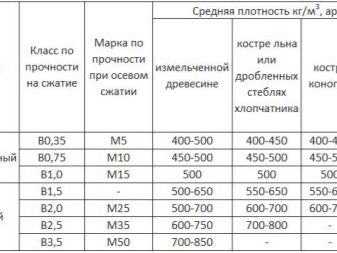
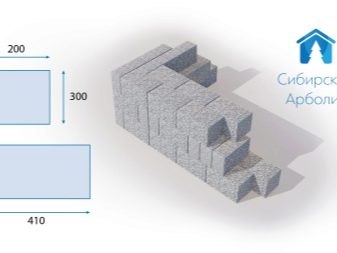
Speaking about the dimensions and characteristics of wood concrete blocks in accordance with GOST, one cannot but say that it strictly regulates the maximum deviations of dimensions. So, the length of all ribs may differ from the declared indicators by no more than 0.5 cm. The largest difference in the diagonals is 1 cm. And the violation of the straightness of the profiles of each surface should be no more than 0.3 cm. The higher the structure, the less seams will be laying, and the fewer the number of seams will be.
Sometimes the so-called "northern arbolite" is found, the length of which does not exceed 41 cm. In some of the rows, when bandaging, the width of the wall coincides with the length of the block, and in the other part it is the sum of two widths and the seam separating them.
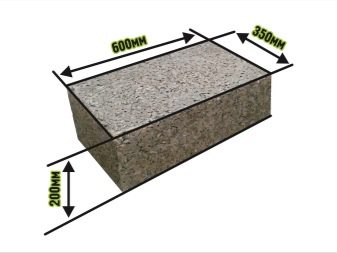
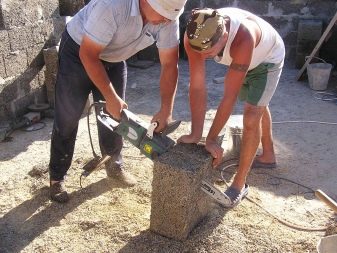
Almost all manufacturers make baffle blocks. In the line of each company, the size of such products is 50% of the standard size. Occasionally, constructions of 50x37x20 cm are found. This allows you to erect walls exactly 37 cm without resorting to bandaging blocks or applying panels.

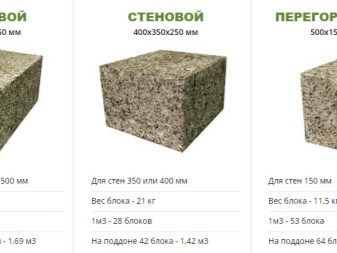
Properties, advantages and disadvantages
For a private developer, when choosing a building material, the technical characteristics of the material are important. Let's look at wood concrete blocks from this side. So, the characteristics and their short decoding:
- Thermal conductivity - 0.08 - 0.14 W / m ° C (depending on the density, the higher the density, the higher the thermal conductivity). The characteristics are comparable to those of wood. She has this indicator of 0.14 W / m ° C, for ceramic bricks 0.6-0.95 W / m ° C. That is, the doi made of wood concrete blocks will be warm, and the width of the walls is small. For central Russia, it is recommended to make walls 30-40 cm thick in houses of permanent residence.
- Frost resistance - 25-50 cycles. This parameter means that walls can freeze / freeze from 25 to 50 times without prejudice to their qualities (depending on the manufacturer). If the house is a permanent residence, then it will not freeze at all. For unheated summer cottages, the service life of 25-50 years is quite acceptable.
-
Compressive strength - 0.5-5 MPa. This is one of the most attractive features of wood concrete - it is difficult to destroy it. Another point: it regains its shape after removing the load. That is, by hitting with a sledgehammer, you can make a dent, but after a while it will even out - partially or completely depends on the "severity" of the damage.
- Flexural strength 0.7-1 MPa. This means that when some distortions appear in the structure (the foundation has sat down unevenly), the wood concrete blocks will not burst, they compensate for a rather large load.
The properties are very good. Another thing is that they will only be subject to exact observance of proportions and technology. This is why arblite blocks are dangerous: you don't know how well they are made.
Performance characteristics
As you can see, the characteristics of the arboblock are not bad. To the pluses, you still need to add light weight, large size and good ability to absorb sounds. A very big plus - the blocks are easy to cut, it is easy to give them the desired shape. Another positive point is that nails and screws hold well in the arbolite. On this side, too, no problems.
- Shrinkage - 0.5-0.6%. This parameter shows how much the geometric dimensions of the wall will change under load. The wood concrete has one of the lowest rates.
- Water absorption 40-85%. This figure is very large. If you put a wood concrete block in water, it can absorb a lot of water. For the developer, this means that it is necessary to take care of a good shut-off waterproofing between the foundation and the first row of blocks. Also, an arbolite house needs an exterior finish that will protect the material from moisture. Not so scary.It is much more important that the hygroscopicity of wood concrete is low (the ability to accumulate vaporous moisture). Even in very humid air, it does not get damp, but passes vapors through itself, regulating the humidity in the room.
- Fire resistance - class G1. Arbolite refers to materials that do not support combustion. This is their undoubted plus.
If we talk about technical characteristics, then there is essentially one serious minus - high water absorption. There is one more drawback, but it is from the field of exploitation. Arbolite is very fond of mice. The material is natural and warm. You can solve the problem by making a high base - at least 50 cm.
What is the material
Arbolite has been used in construction for a long time. Material requirements are established in GOST 19222 * 84.
For the production of wood concrete, a binder (cement) component, organic fillers and additives are used to adjust the characteristics. The material is used for the construction of structures for various purposes.
 Arbolit (wood block)
Arbolit (wood block)
The composition of the mixture (content of cement, water and chemical additives) for the manufacture of the material may vary depending on the type and fraction of organic matter.
In accordance with the current standard, manufacturers produce two types of wood concrete.
Table. Types of material.
| Material | Density, kg / m3 | Compressive strength, brand |
|---|---|---|
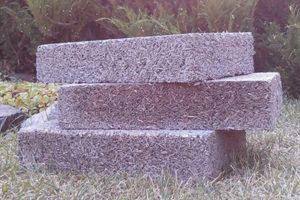 Heat insulating Heat insulating
|
400…500 | M5, M10, M15 |
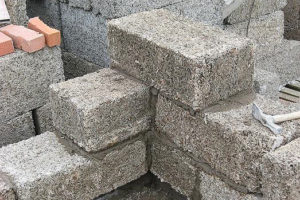 Structural Structural
|
500…850 | M25, M35, M50 |
The scope of application of structural wood concrete is the construction of low walls (2, 3 floors) and partitions, the arrangement of jumpers over openings and an armored belt. Thermal insulation material is needed for thermal insulation of walls and ceilings, as well as noise protection. The erection of load-bearing structures from products made of wood concrete with a density below 500 kg / m3 is prohibited.
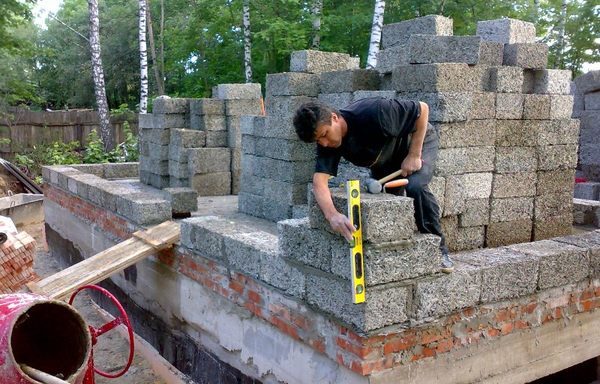 Arbolite blocks masonry
Arbolite blocks masonry
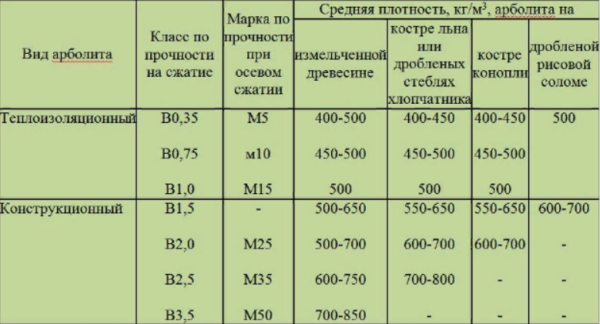 Wood concrete type and characteristics
Wood concrete type and characteristics
The relative humidity inside wood concrete buildings should not exceed 60%. Also, the presence of an aggressive gas environment is not allowed.
Blocks are produced from wood concrete, which are most in demand among consumers, and panels (they are mainly used for floor insulation).
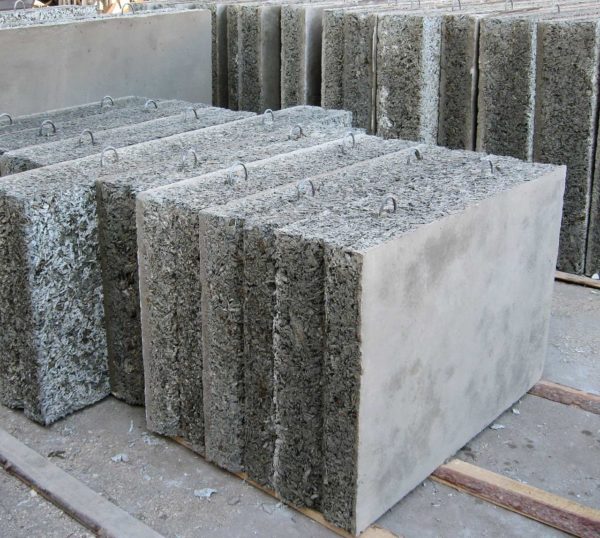 Wall wood concrete panels
Wall wood concrete panels
What are the characteristics of wood concrete blocks?
The coefficient of thermal conductivity of the material, depending on the organic filler, can be:
- 0.08 ... 0.17 W / (m × ° С) - for products with wood in the composition;
- 0.07 ... 0.12 W / (m × ° C) - for products with other types of filler.
This heat-insulating ability of the material allows a wall with a thickness of only 30 cm to resist the penetration of cold as effectively as a meter-long brick.
When shipped to the consumer, wood concrete should not have a moisture content exceeding 25%.
The frost resistance of the material can be F 25 or F 50. In terms of resistance to biological damage, it belongs to the V group. Arbolite can withstand exposure to fire for up to 90 minutes.
 Comparison of wood concrete with other materials
Comparison of wood concrete with other materials
Arbolite blocks can be reinforced. In this case, welded mesh or steel bars with a coating that protects against corrosion are used. The thickness of the concrete layer to the reinforcement should not be less than 1.5 cm. Embedded parts can also be installed in the wood concrete.
 How is the reinforcement of wood concrete blocks carried out?
How is the reinforcement of wood concrete blocks carried out?
About the material
Arbolite block is a large-sized masonry stone used in construction as a wall material and heat-insulating material. The main components of the arboblock are binder, filler, chemical additives that provide accelerated maturation of the material, frost resistance, mineralization of chips, and water.

Blocks are produced in different regions of different sizes, this is due to the provision of enclosing structures with the required heat transfer resistance standards:
- in the central part of Russia, where a wall thickness of 390 mm is sufficient, blocks are produced with standard sizes of 500x200x300, 500x250x200 and 500x200x200;
- in the northern regions, the Volga region and further to the East, where a wall thickness of 410 or 450 mm is required, there the block has a size of 600x410x200, 450x250x300.
Manufacturers adjust the block sizes to the needs of the regions for the convenience of the consumer.
Arboconcrete products are manufactured for various purposes:
- heat-insulating blocks and plates of compressive strength class B0.35 ... B1.0, and with a density of 400 ... 500 kg / m3;
- structural blocks and plates of compressive strength class B1.5… B3.5 and density 500… 850 kg / m3.
Arbolite structural blocks are intended for the construction of residential buildings with a height of up to 3 floors.
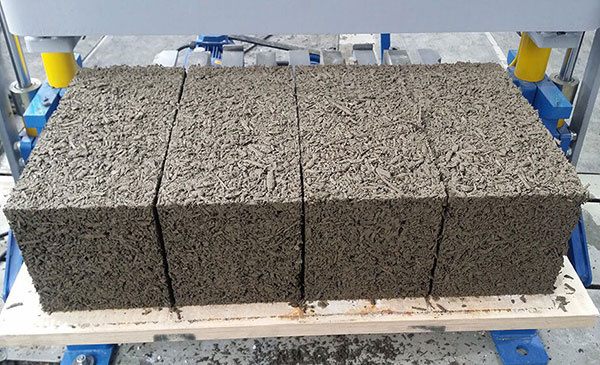
The main characteristics of blocks made of wood concrete:
- light weight - buildings do not require a strong foundation, the costs of lifting and transport equipment are reduced, and the laying speed is increased;
- low thermal conductivity - to ensure the required heat transfer resistance of the external enclosing structure in the Moscow region, a wall 370 mm thick from block D 600 is sufficient;
- vapor permeability - the material breathes, creating a comfortable microclimate inside the building;
- biostability - walls are not affected by mold or fungus, rodents are indifferent to the material;
- fire resistance - flammability group G3 (hardly combustible);
- environmental friendliness - all components of the material are of natural origin and do not emit harmful substances during manufacture and operation;
- durability - some buildings have crossed the 50-year mark;
- ease of processing - the material is easily cut with a circular saw, holds nails and screws well.
The disadvantage is water absorption from 40 to 85% of the volume; to reduce this indicator, the filler is pre-dried and treated with various chemicals. It is forbidden to lay out structures that are subject to high atmospheric load from arboblocks - a base, a cornice, a parapet.
Production of wood concrete blocks
If the composition for them is prepared correctly and has the desired consistency, then the process is not difficult, regardless of whether you make them by hand or use a shaking shaker. Only change molds for making and molding technology.
The simplest forms can even be made of wood, it is important that the output is blocks with exactly the same size

Often, such forms are lined with linoleum from the inside for easier stripping. Metal molds are more durable and blocks have a smoother surface after stripping. In them, you can better tamp the mixture with a manual rammer.
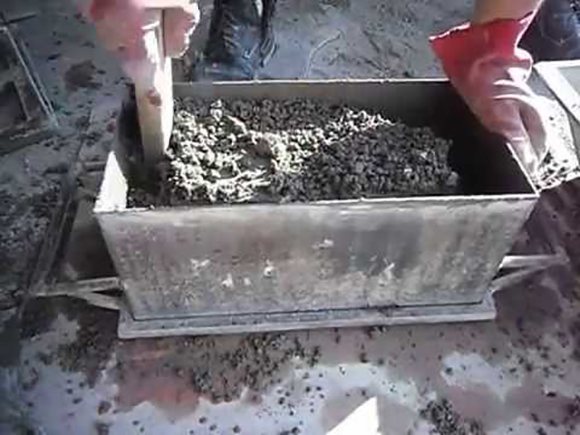
The process of making blocks in this form is shown in the video:
The measuring spatula allows for a more precise dosage of the material. With the use of such devices, it is possible to produce blocks with an textured outer surface.
To do this, some space is left in the upper part of the form, which is filled after molding:
- concrete or polymer concrete;
- textured tiles on cement-polymer glue;
- rigid insulation (foam) with a textured protective layer.
In the last 2 cases, an adhesive is applied to the material to be glued. composition for ceramic tiles or expanded polystyrene, respectively, or you can use home-made adhesive cement-sand mixtures with the addition of dispersed PVA.
When manually making blocks, you can also make window and door lintels from wood concrete mixture.
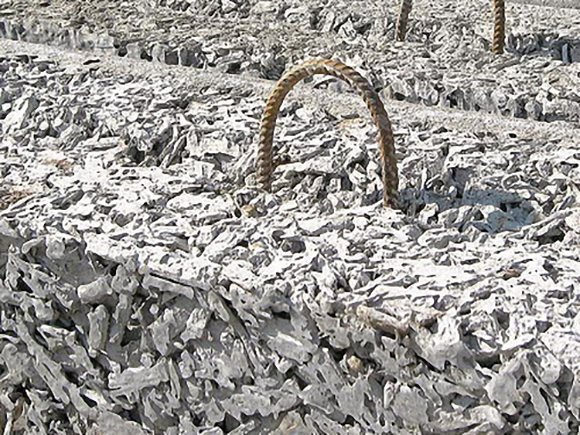
On the Russian market there are quite a few vibrating machines for the manufacture of wood concrete blocks. They have different designs and performances, but the principle of block formation is very similar:
A skilled home craftsman with the skills of a welder can easily make such a machine on his own. A characteristic feature of the majority of such devices is the presence of a dosing container, which makes it possible to obtain blocks of a stable shape and the same density with a constant recipe for preparing a mixture and homogeneous ingredients.
Such equipment can be used to form blocks from other materials. Drying of molded wood concrete blocks occurs within 2 weeks at a temperature of ± 20 ° C.
Advantages of using wood concrete blocks
Arbolit is a lightweight concrete used for the production of building blocks.

It includes:
- Sulfate resistant high quality cement (Portland cement).
- Mineral binders.
- Wood waste - sawdust, shavings, wood chips, in connection with which arbolite received another name - wood concrete.
- Rice straw.
- Cellulosic organic raw materials.
- Water.
- Chemical reagents.
The latter, in turn, have a significant effect on the quality characteristics of the material, such as porosity, hardening time, etc. Instead of Portland cement, water glass or ash can be used as an option.
The scope of application depends on the density parameter of the material. With a density of 500-800 kg / m 3, it is used for the construction of small buildings. If this figure is lower, wood concrete is used as a heat insulator. In this case, it is produced in the form of sheets.
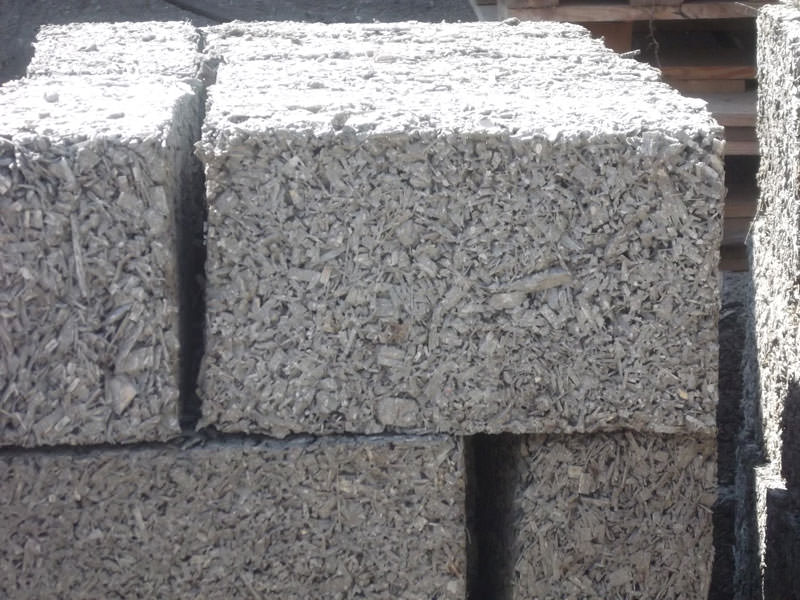
Hence the main the merits of this material:
- Low thermal conductivity saves money during the cold season. A 30 cm wall made of wood concrete block retains heat perfectly.
- Strength depends directly on the density of the material. With an indicator of 600 kg / m3, arbolite is not inferior to gas and foam concrete.
- Plasticity is due to the content of wood waste. This prevents cracking and slight deformation does not damage the material.
- For wood concrete walls, there is no need to fill in the reinforcing belt, which greatly facilitates the construction process.
- Frost resistance allows it to withstand up to 50 freeze-thaw cycles, increasing the service life of the structure up to 50 years.
- Low carbonation shrinkage.
- Soundproofing properties are slightly higher than that of any other building materials.
- Light weight makes it easy to build a foundation.
- Environmental friendliness is due to the presence of natural ingredients in the composition.
- Durability.
- Fire safety. Despite the fact that it contains wood-based materials, wood concrete does not support combustion.
- Resistant to decay, mold and mildew due to lack of moisture. Arbolite not only absorbs moisture well, but also gives it away.
- Steam and air permeability. Walls made of this material "breathe" providing natural ventilation.
- During construction, wood concrete blocks are easy to process - they are well sawn, drilled. In addition, in the process of plastering, there is no need for a reinforcing mesh.
- The cheap cost is determined by the cost of the constituent elements.
- Wear resistance, resistance to mechanical damage.
Another undoubted advantage of this material is the ability to produce it yourself with your own hands. The dimensions can be adjusted.
Pros, cons and limitations of use
Arbolit has been used successfully in construction for a long time. During this time, all the advantages and disadvantages of the material, as well as ways of dealing with the latter, have been fully revealed. The only serious restriction on the use is on the use of wood concrete in multi-storey construction - a house above three floors cannot be built from it.
In other cases, the feasibility of its use is considered depending on the advantages and disadvantages of the material.
What is good about arbolite
This building material is quite simple to manufacture - it can even be done by hand, for which a simple concrete mixer is enough. In addition, there are enough other advantages:
- Good resistance to mechanical stress. At the same time, the block can be sawed with an ordinary hacksaw on wood to give the desired shape.
- Arbolite is a light material, so a strong foundation is not needed for a house built from it.
- Manufacturing technology makes the material unattractive to termites and similar insects, and also makes the walls resistant to fungi and mold.
- Arbolite blocks are larger and lighter than analogues made of cinder block, foam or aerated concrete.The dimensions allow to reduce the number of operations (brought-packed), which will accelerate the overall pace of construction. If the cinder block weighs 8 kg, then an equal size wood concrete material is about 4 - less effort will be spent on its transportation. At the same time, the strength of wood concrete is about the same.
- Arbolite walls lend themselves well to drilling - you can hammer in nails or tighten screws in them, where they hold like in wooden boards.
- Excellent insulating material - sometimes used as insulation.
- Arbolite does not burn. Prolonged exposure to high temperatures may begin to smolder, but little smoke is emitted.
- Unlike brittle concrete, arbolite blocks are able to withstand much higher tensile loads, therefore, cracks in the walls of this material can appear only as a result of a gross violation of construction technology.
- Arbolite does not contain harmful chemical compounds, which makes it an environmentally friendly material.
- The vapor permeability values of the material are similar to wooden products - the walls are "breathable" and do not need additional ventilation.
- Durability. According to technical characteristics, the frost resistance of wood concrete is up to 50 freezing cycles. If we take into account that freezing can damage only damp material, with proper and timely treatment of walls with plaster, their service life will be much more than 50 years.
Material disadvantages
The production technology implies a large amount of manual labor - for example, the automation is not capable of stripping the formwork and is left to mix the components. The rest, if possible, is done in a semi-automatic mode, but if there are less than 3-4 people on the maintenance of the machine for the production of wood concrete, then the speed of work will drop significantly. The material for manufacturing is inexpensive in itself, but a significant part of the cost is the wages of workers.
Breathable walls at the same time imply a high level of hygroscopicity of the material. If the blocks are saturated with moisture, especially before freezing, then their service life will sharply decrease. Plastering walls allows you to cope with this problem.
In the autumn-winter period, the blocks stored in the warehouse cannot be covered with plaster, so they must be protected from getting wet.
One of the drawbacks of the material can be seen with the eyes - this is its appearance - it looks like chipboard, but the color is like that of a concrete coating. To solve this problem, the walls are plastered or covered with siding. Some manufacturers offer wood concrete with one side already plastered, but there is no particular sense in this, since it is still necessary to plaster the walls, at least to prevent them from getting wet.
In artisanal conditions, which small manufacturers often sin, it is difficult to obtain the exact geometry of the blocks. This means that the seams between them will be thick, and this, in addition to the overconsumption of cement, also additional "cold bridges".


